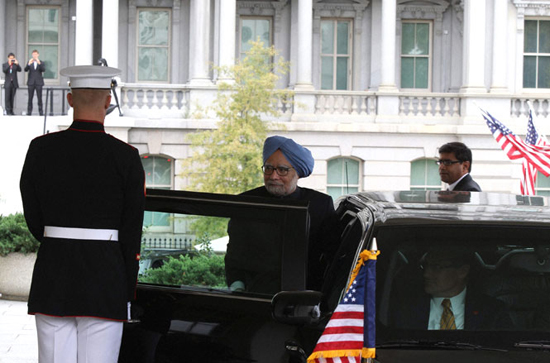
Washington, Sep 28: India and the US have reached the first commercial agreement on civilian nuclear power, five years after a landmark deal between the two countries was clinched.
Addressing a joint media interaction after talks with Prime Minister Manmohan Singh, President Barack Obama disclosed that the two countries have sealed the agreement.
"We've made enormous progress on the issue of civilian nuclear power, and in fact, have been able to achieve just in the last few days an agreement on the first commercial agreement between a US company and India on civilian nuclear power," Obama said.
India's nuclear operator NPCIL (Nuclear Power Corporation of India Limited) and US firm Westinghouse have signed an agreement that will pave the way for setting up an atomic plant in India.
However, there was no word on the tough nuclear liability clause in the Indian laws over which the US firms had strong objections.
There was a major uproar in India last week over the agreement because of apprehensions that it entailed bypassing the Civil Nuclear Liability Law in place in the country by waiving the operator's right to recourse with the supplier.
Reiterating his commitment for strong ties, Obama said India is not just a regional, but also a global power.
Prime Minister Singh reciprocated the feelings, saying US is as an indispensable partner for India.
"India, as a significant not just regional power but world power, has worked closely with us on a whole range of issues from climate change to how we can help feed the world, alleviate poverty and deal with disease," Obama told reporters in his Oval Office following their hour-long meeting.
Praising the Prime Minister for his leadership in strengthening India-US ties, Obama said Singh has been a great friend and partner to the United States and to him personally.
"Across the board, Prime Minister Singh has been an outstanding partner," Obama said, adding that India continues to grow at an amazing rate, but obviously there are a lot of people in India that are still trapped in poverty.
He said US is a strong partner to help India realise that vision because if there is a strong India, that is good for the world and it's ultimately good for the US.
In his remarks, Singh said Obama has imparted a powerful impetus to that process of the two countries being on the same page. "I've always believed that India and America are indispensable partners. During the time that I have been Prime Minister, and particularly during the time that President Obama and I have worked together, I think President Obama has made an outstanding contribution to strengthening, widening and deepening of our cooperation in diverse ways," he said.
Singh said India and America are working together to build on the cooperation and widening, and deepening it in diverse directions.
"We are cooperating in expanding the frontiers of trade investment in technology. Our bilateral trade today is USD 100 billion. Investments in India are USD 80 billion. And they are growing, despite the slowdown in the global economy," Singh said, referring to the increasing trade between the two sides.
"Outside the area of trade technology and investment, we are exploring avenues of cooperation in new areas like energy cooperation, clean coal technology, energy-efficient technology, cooperation in the field of environment, cooperation in the field of defense and security-related, cooperation with regard to the intelligence gathering and counterterrorism.
In all these areas, India needs the United States to be standing by our side," Singh said.





Comments
Add new comment